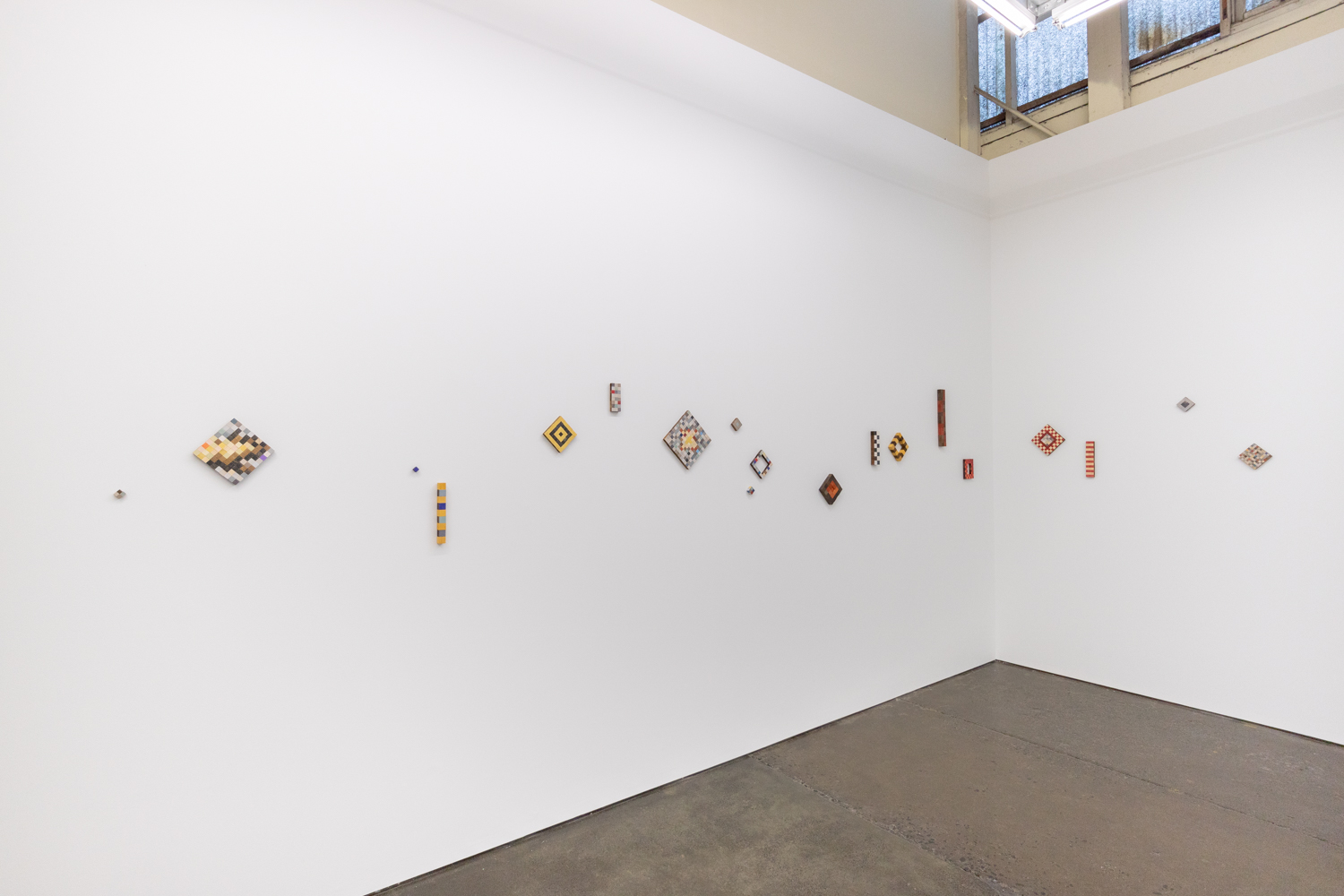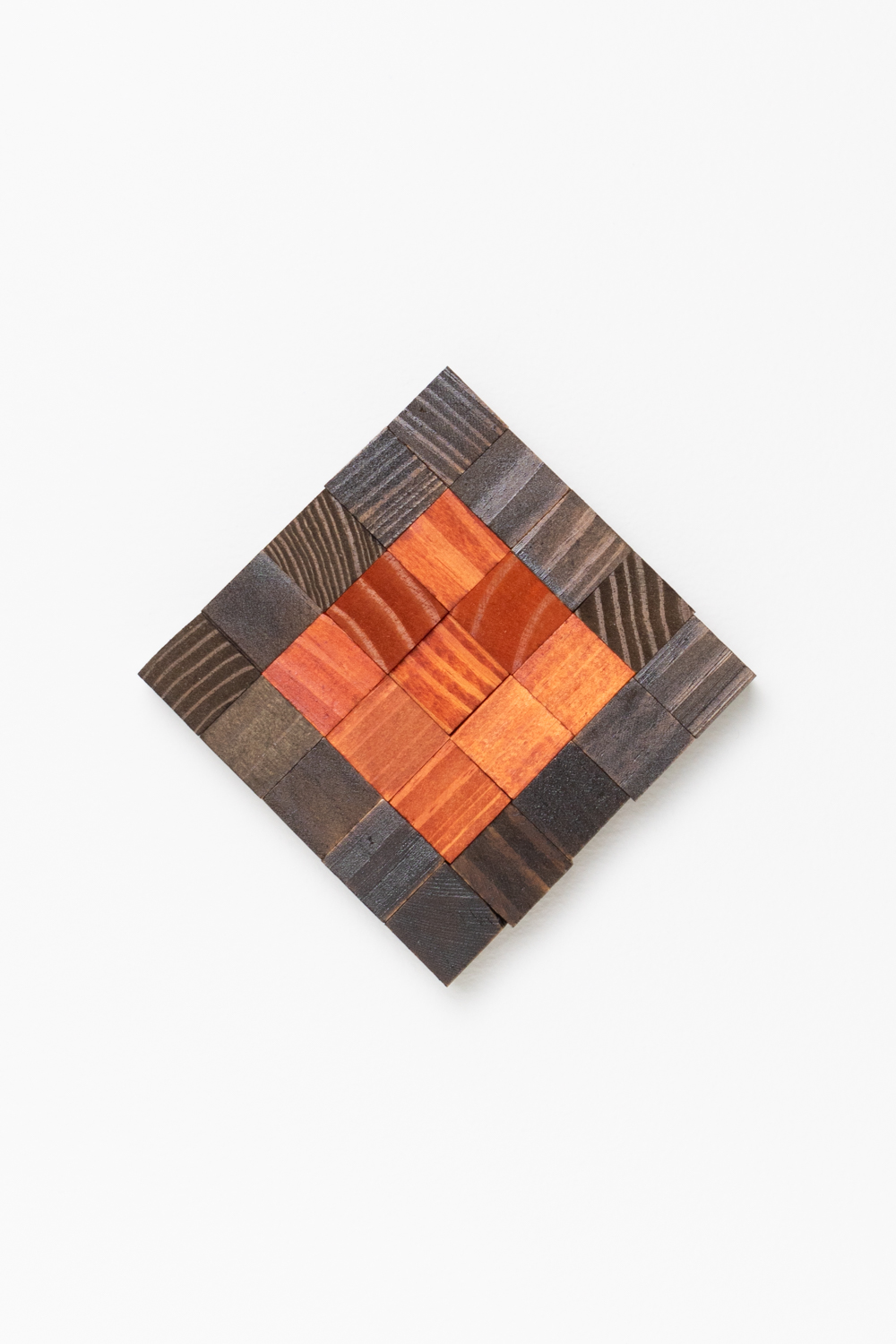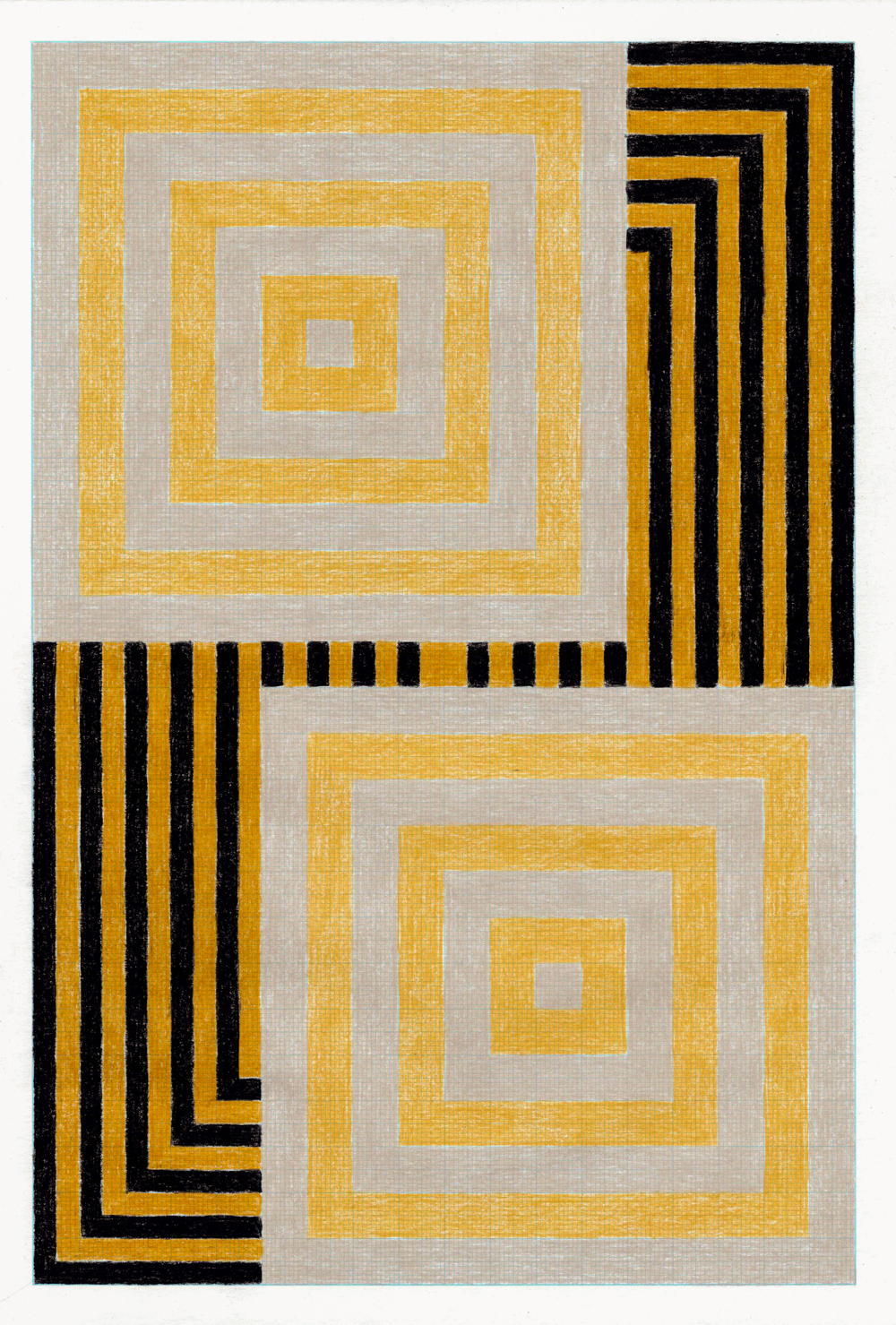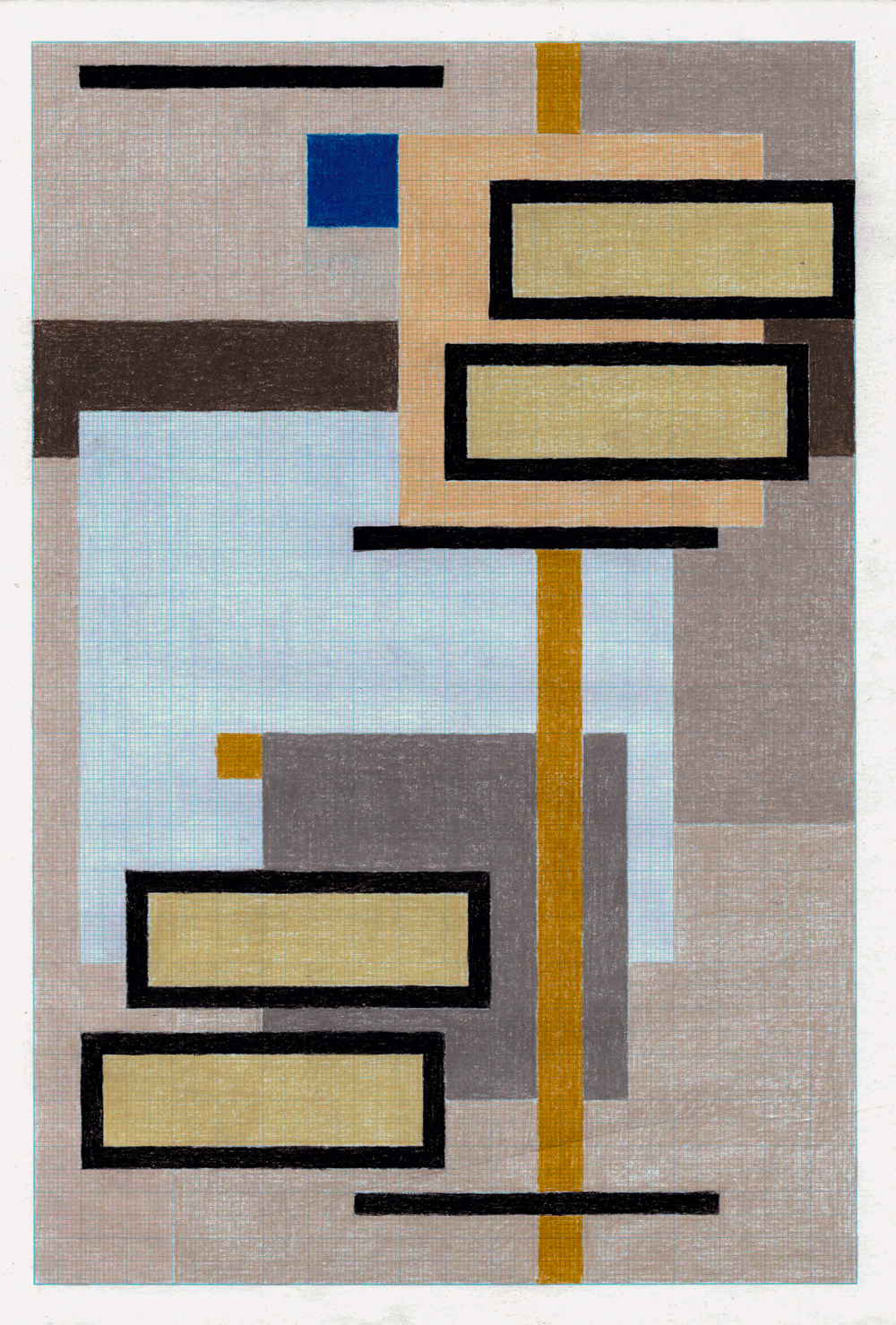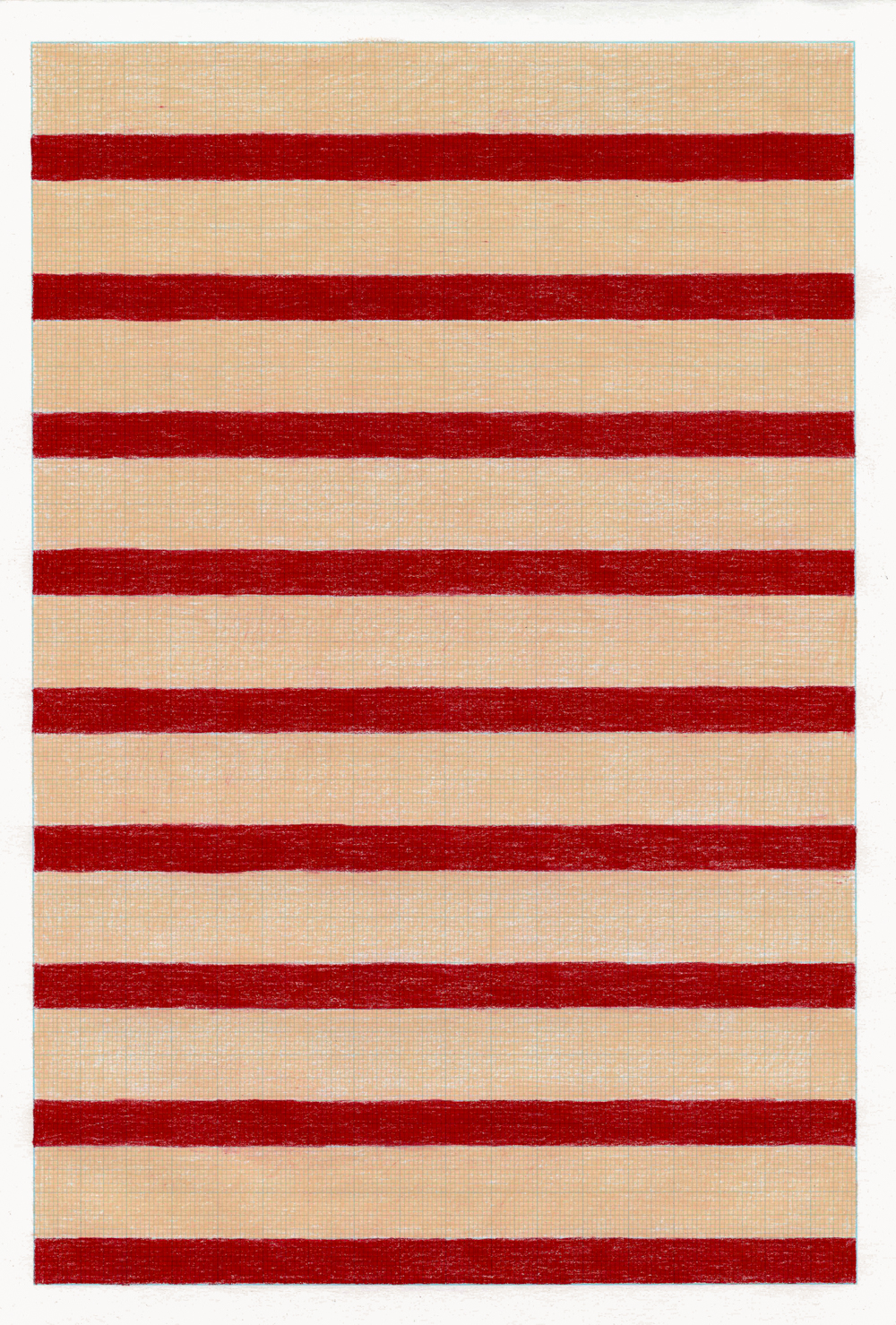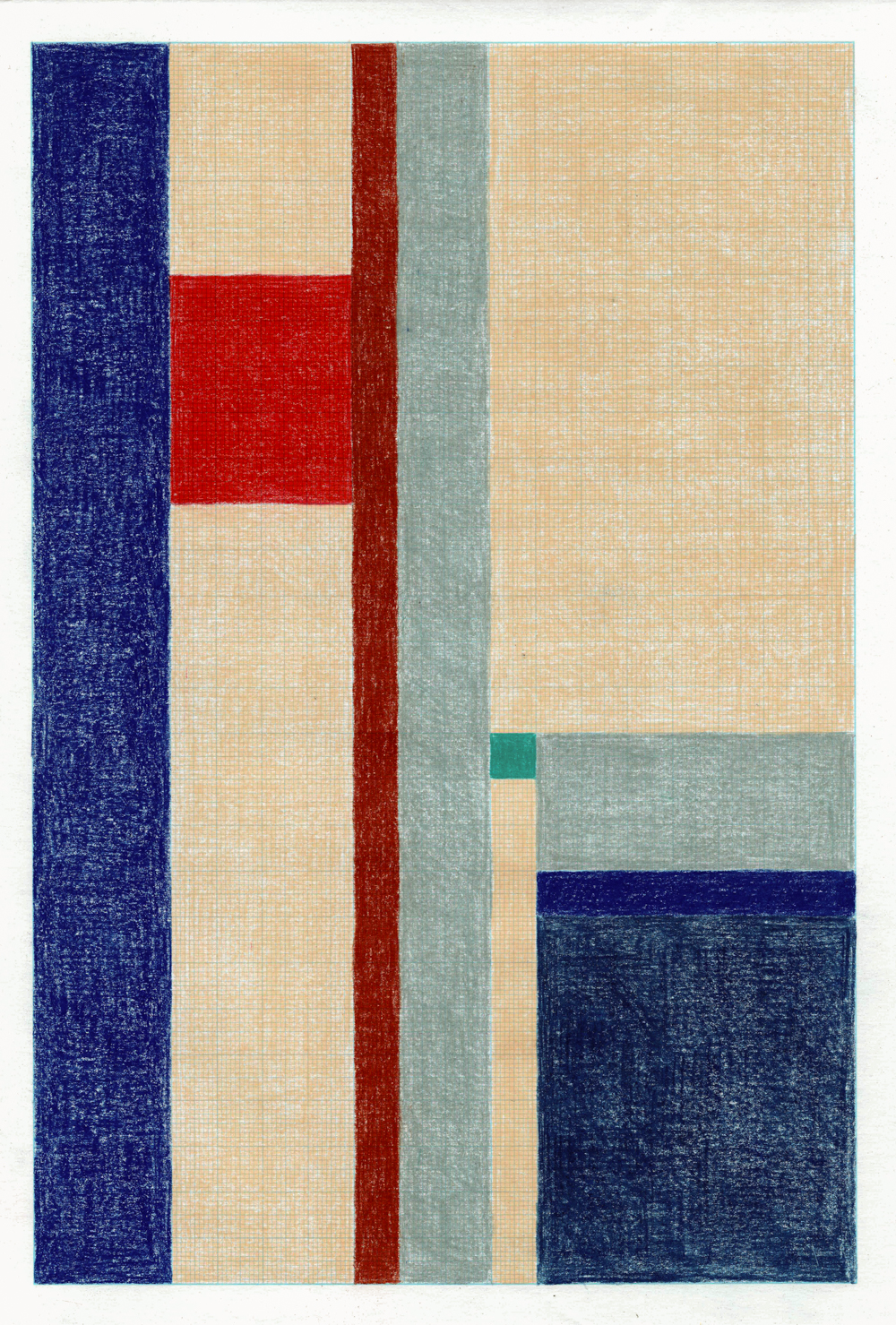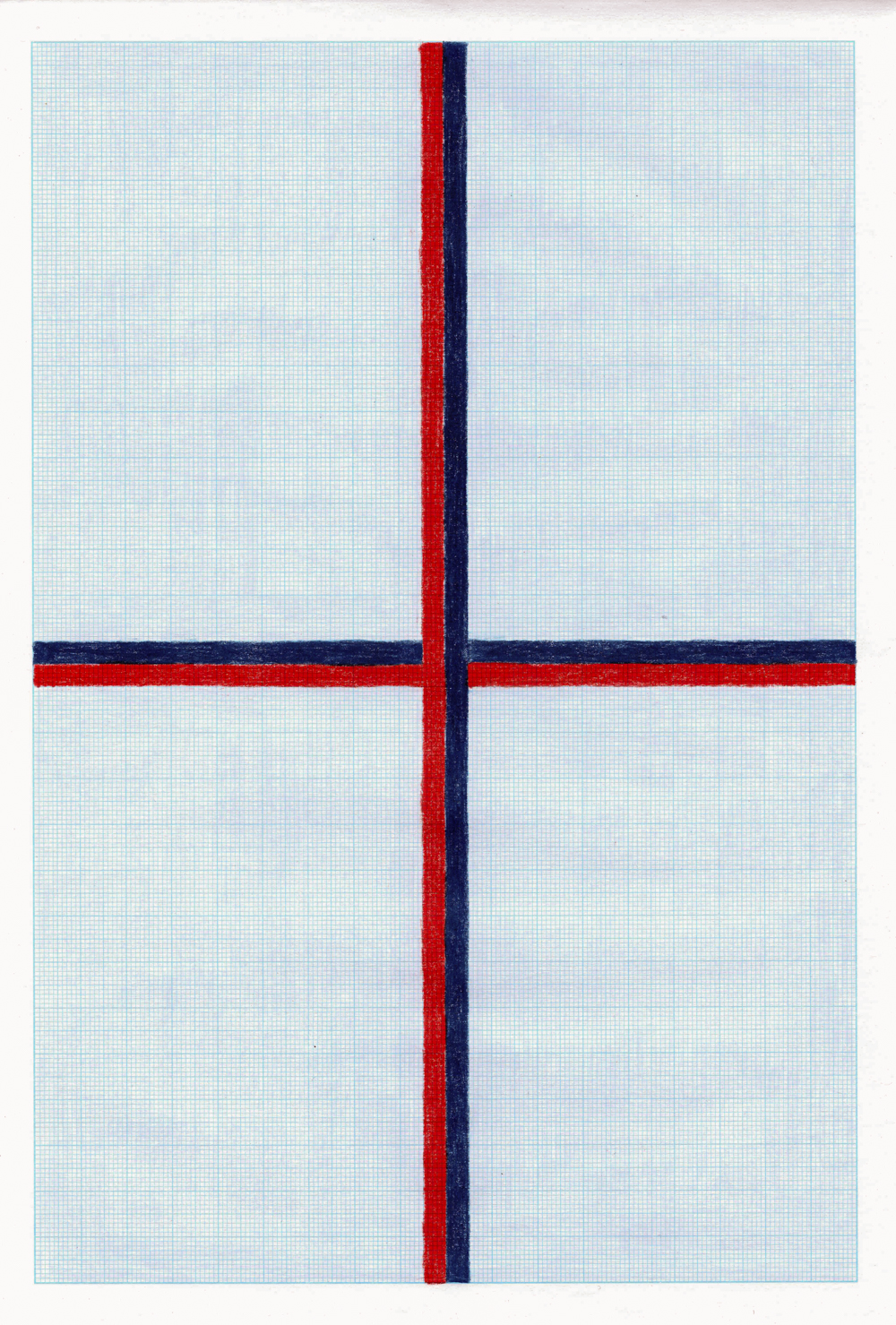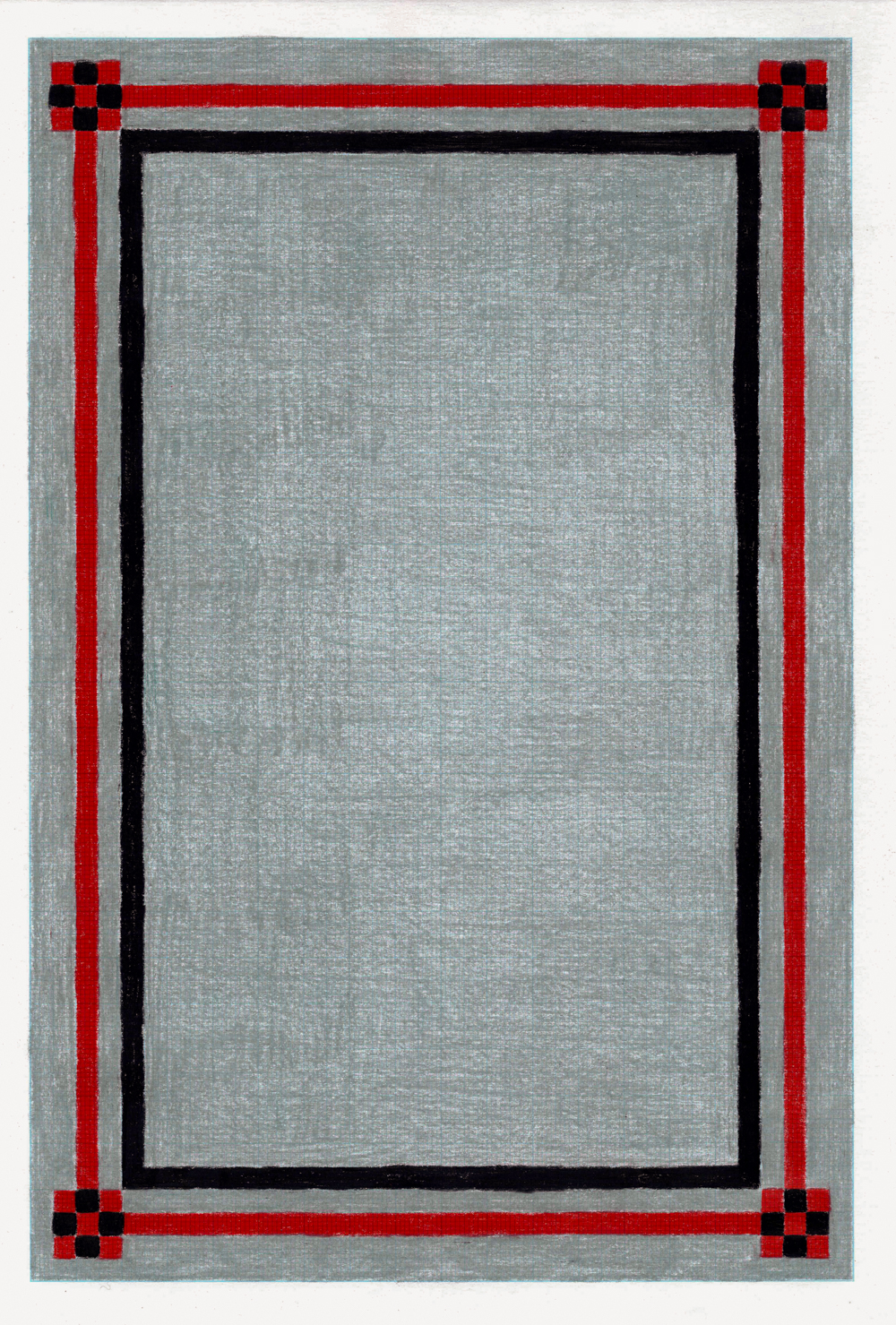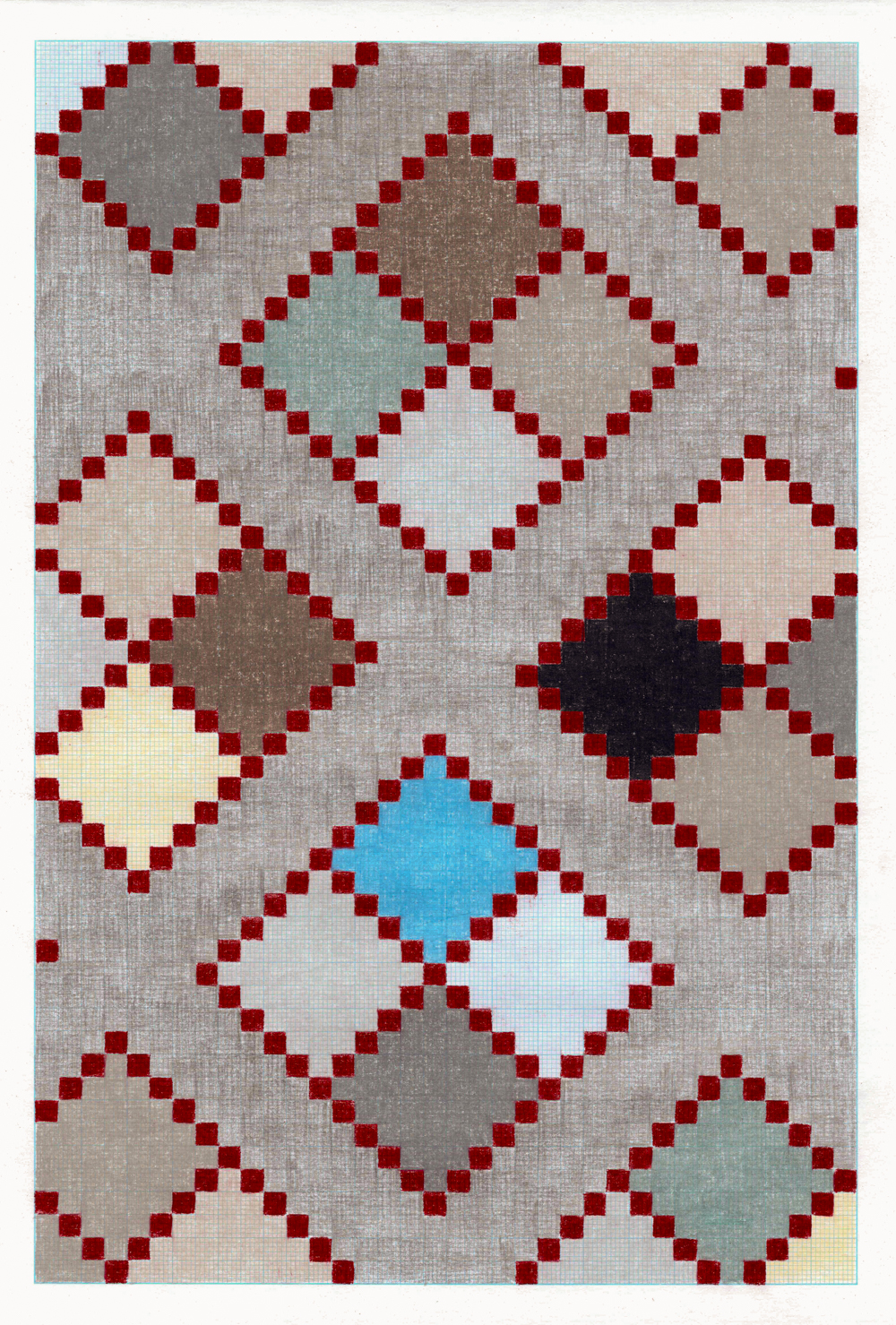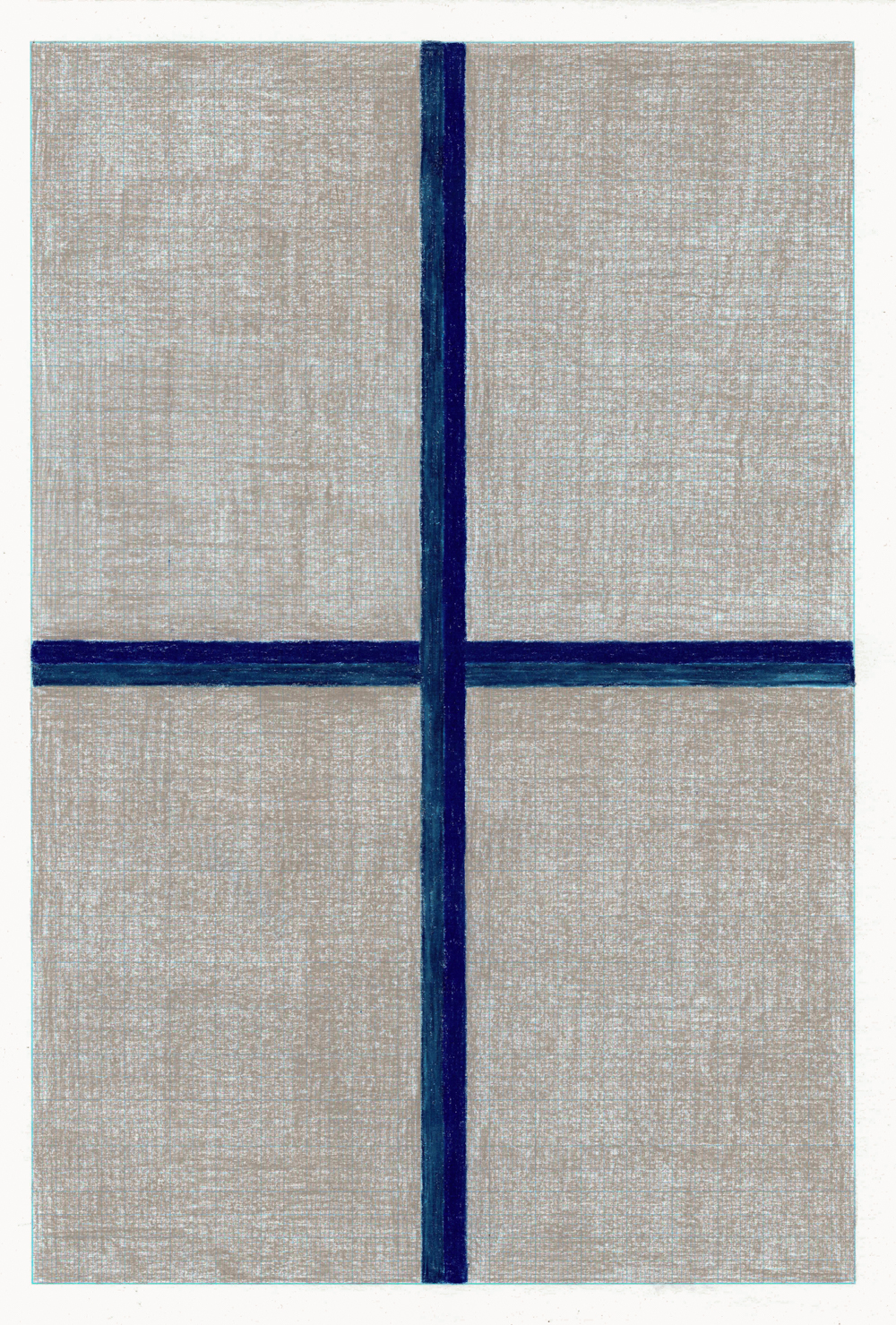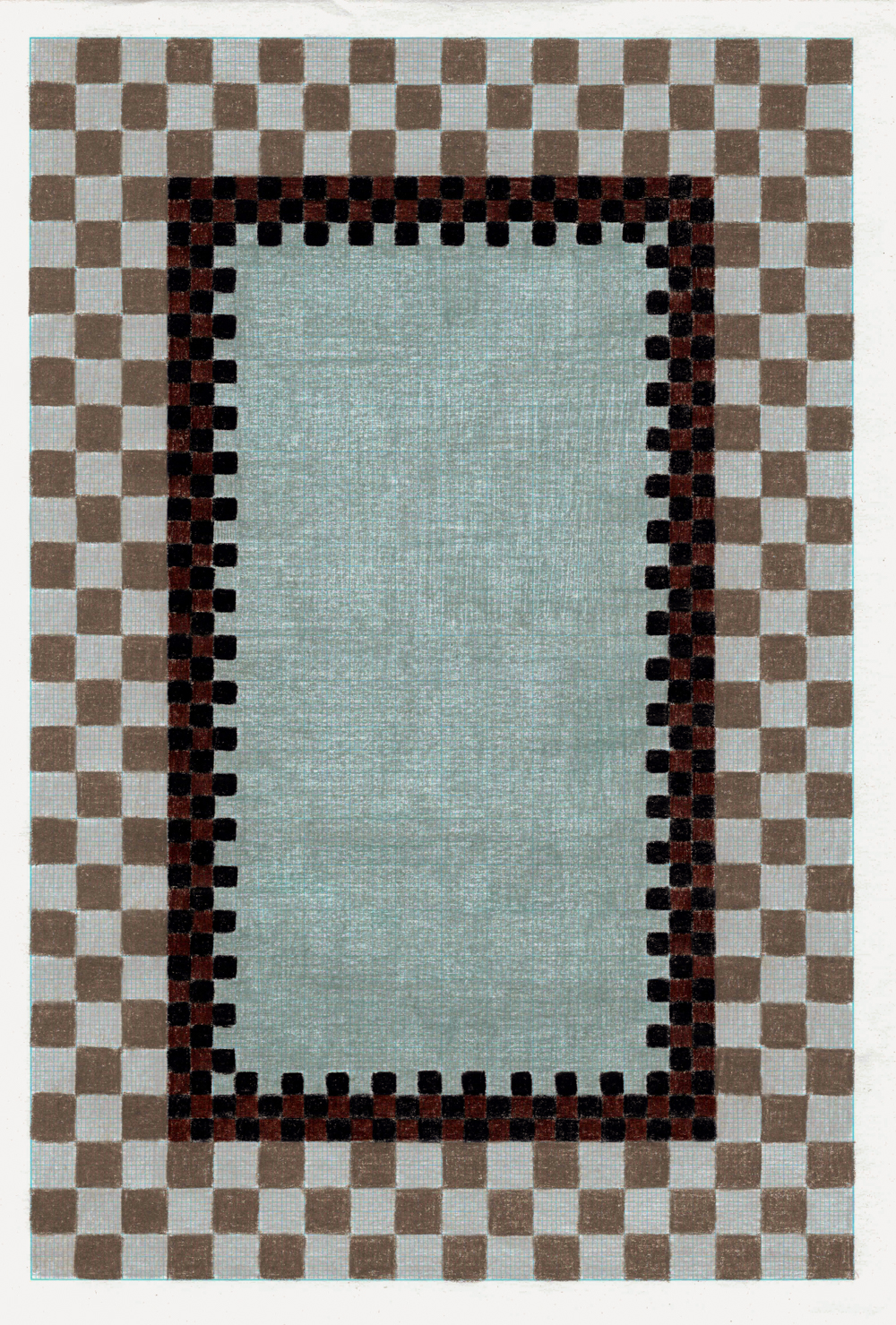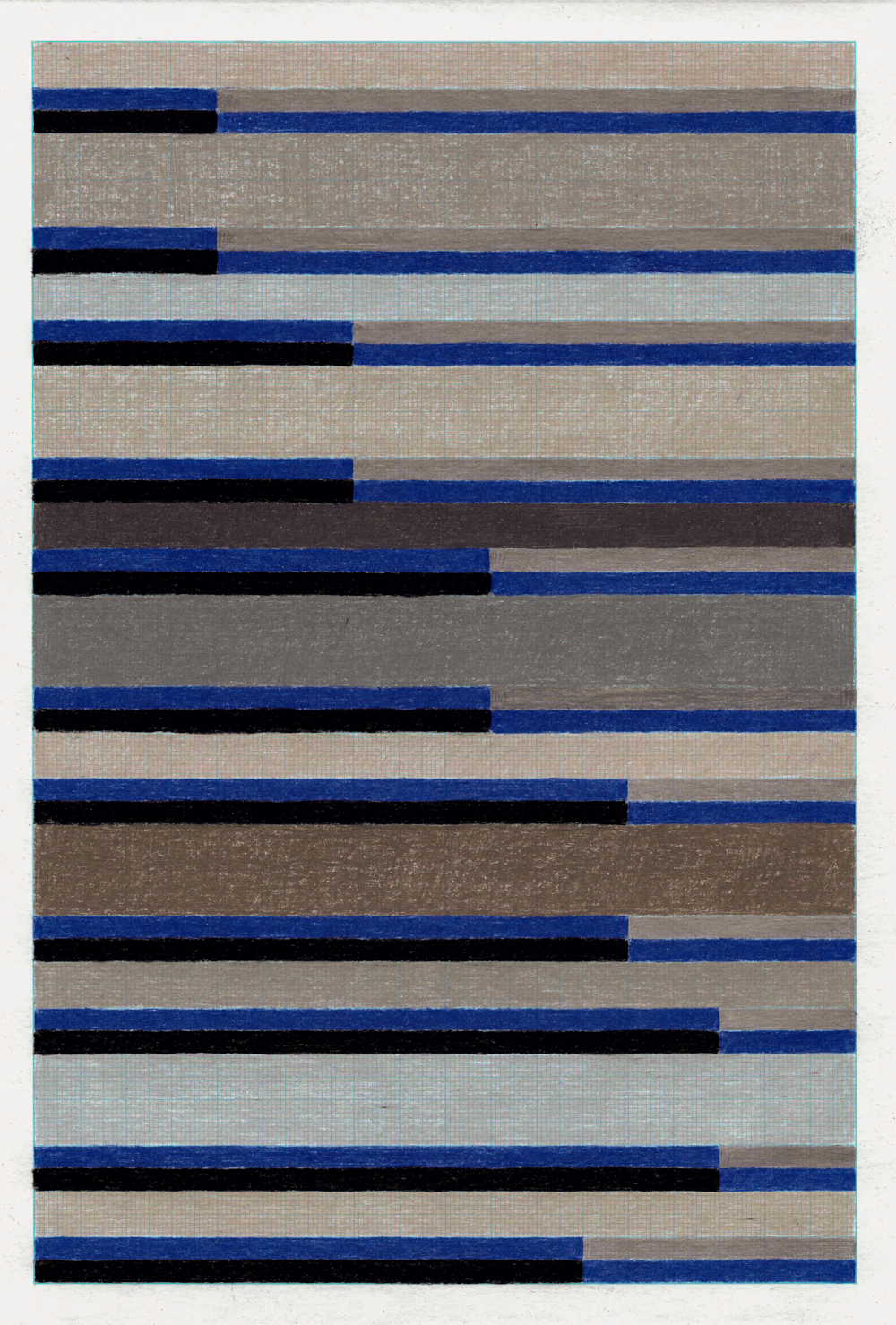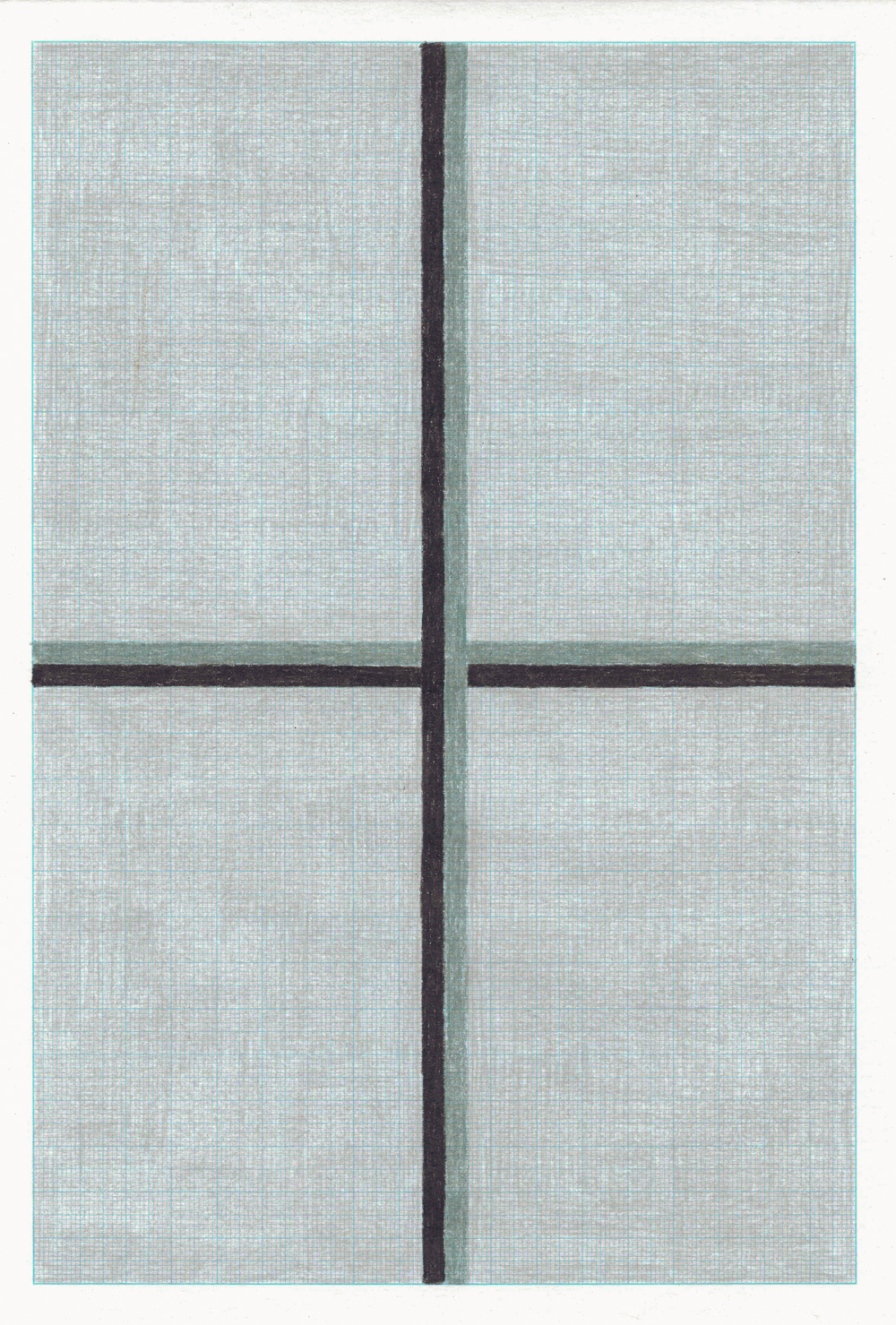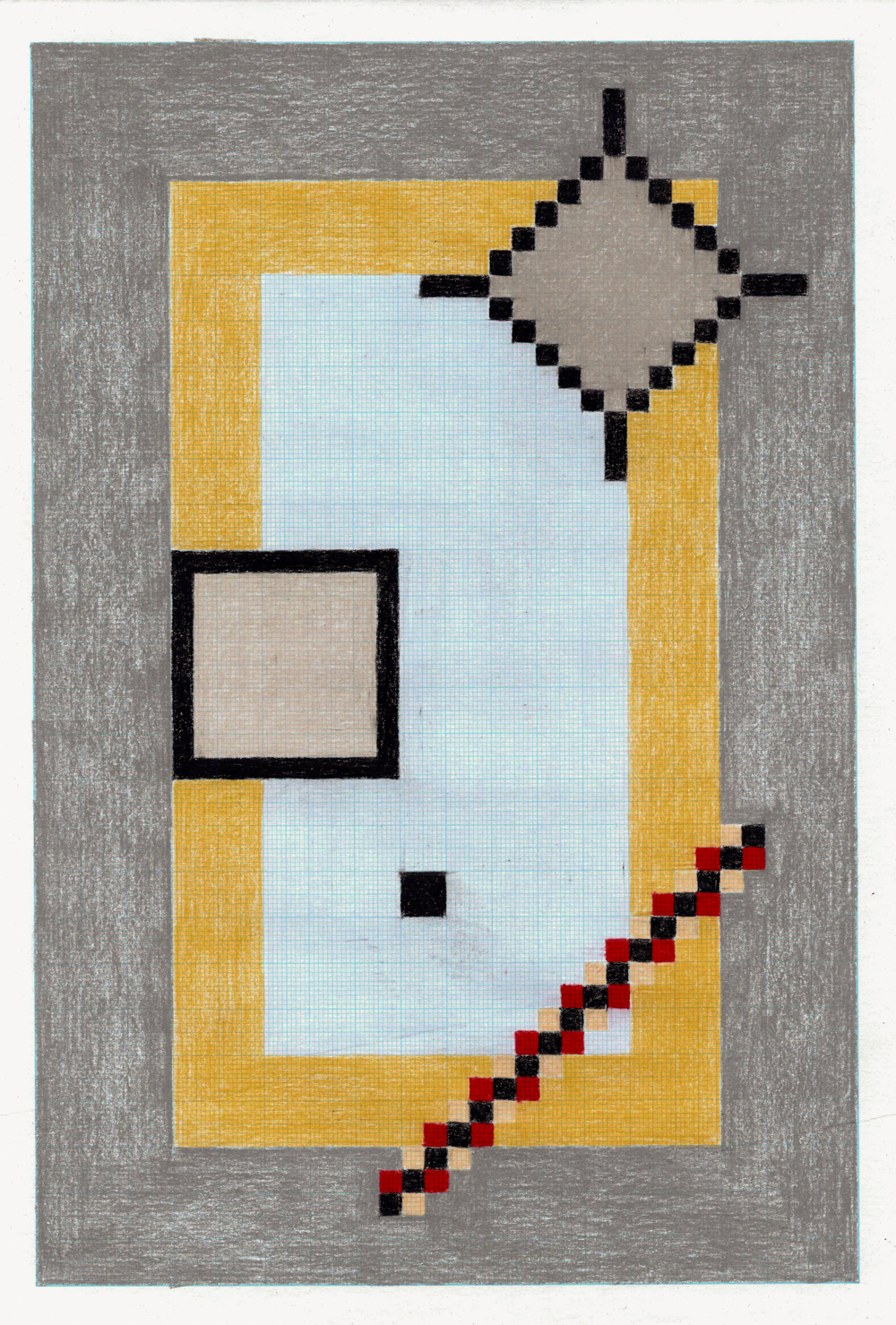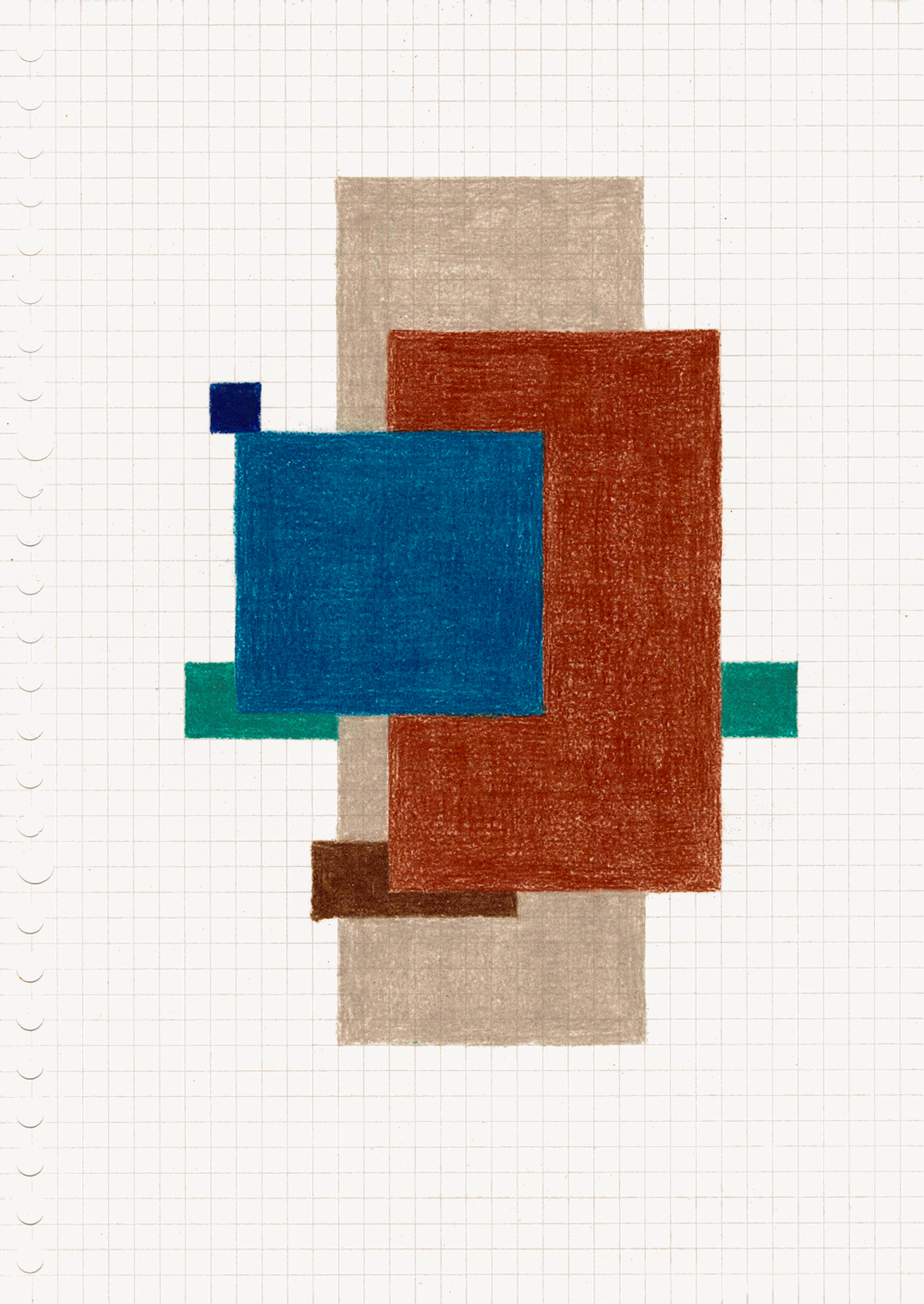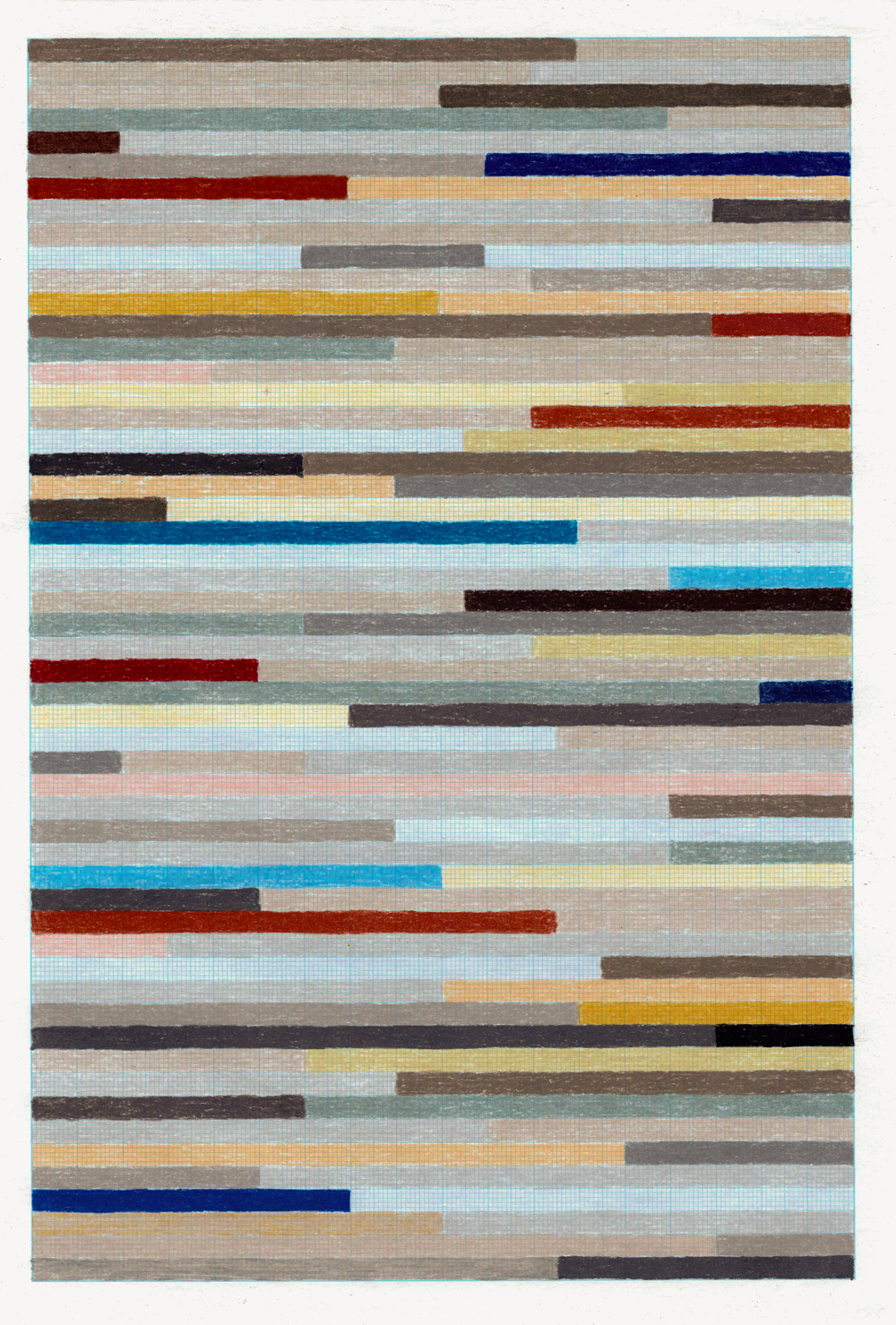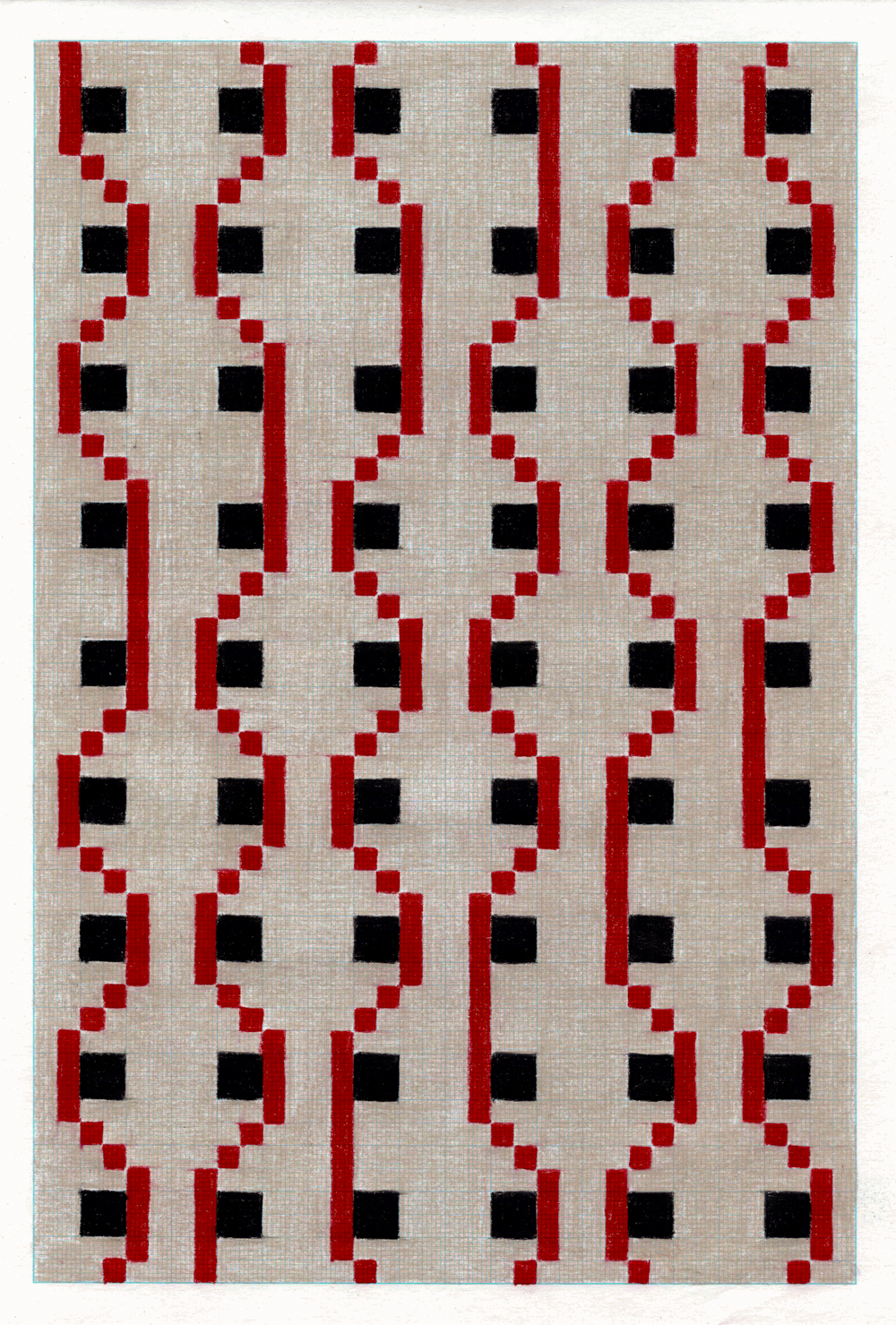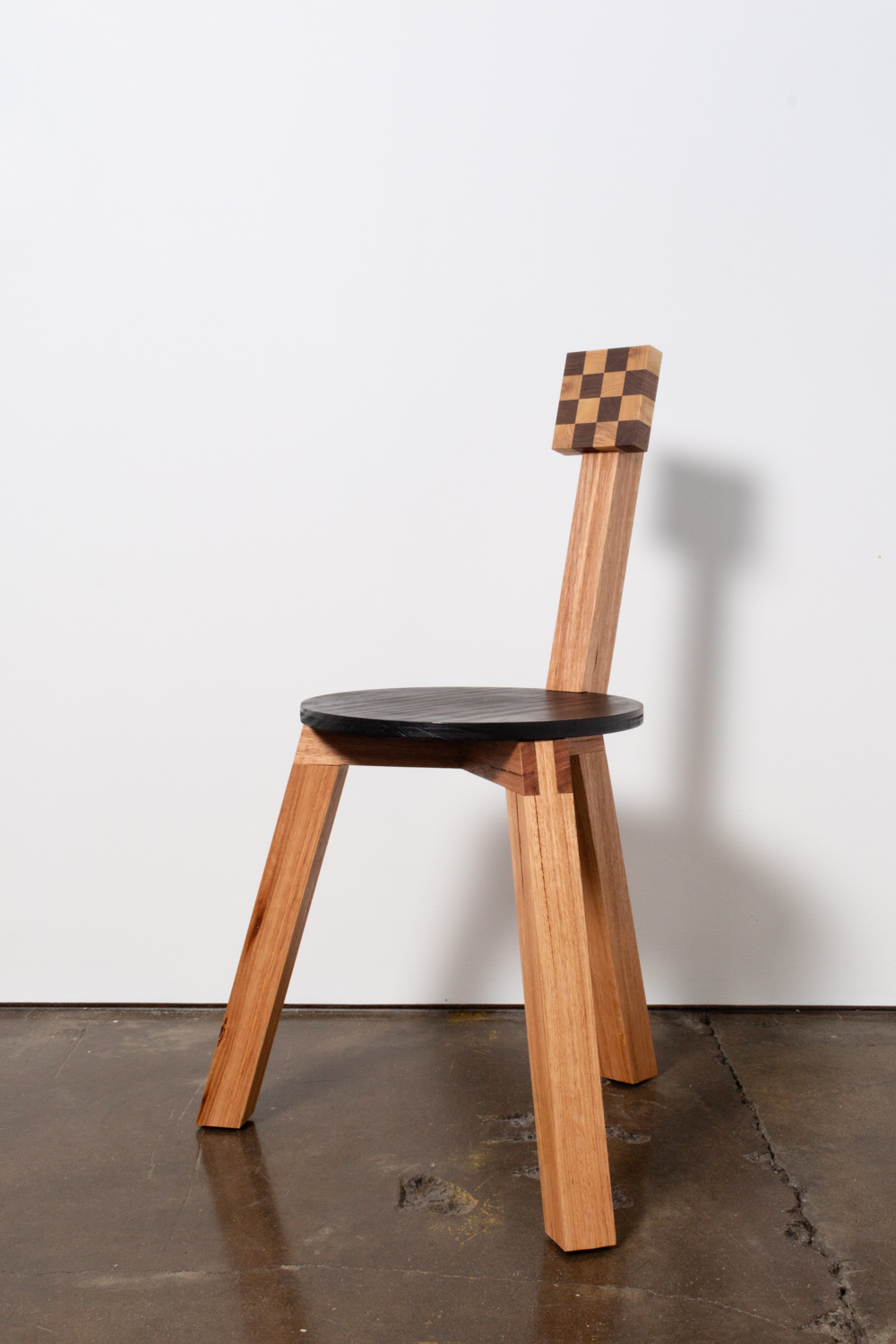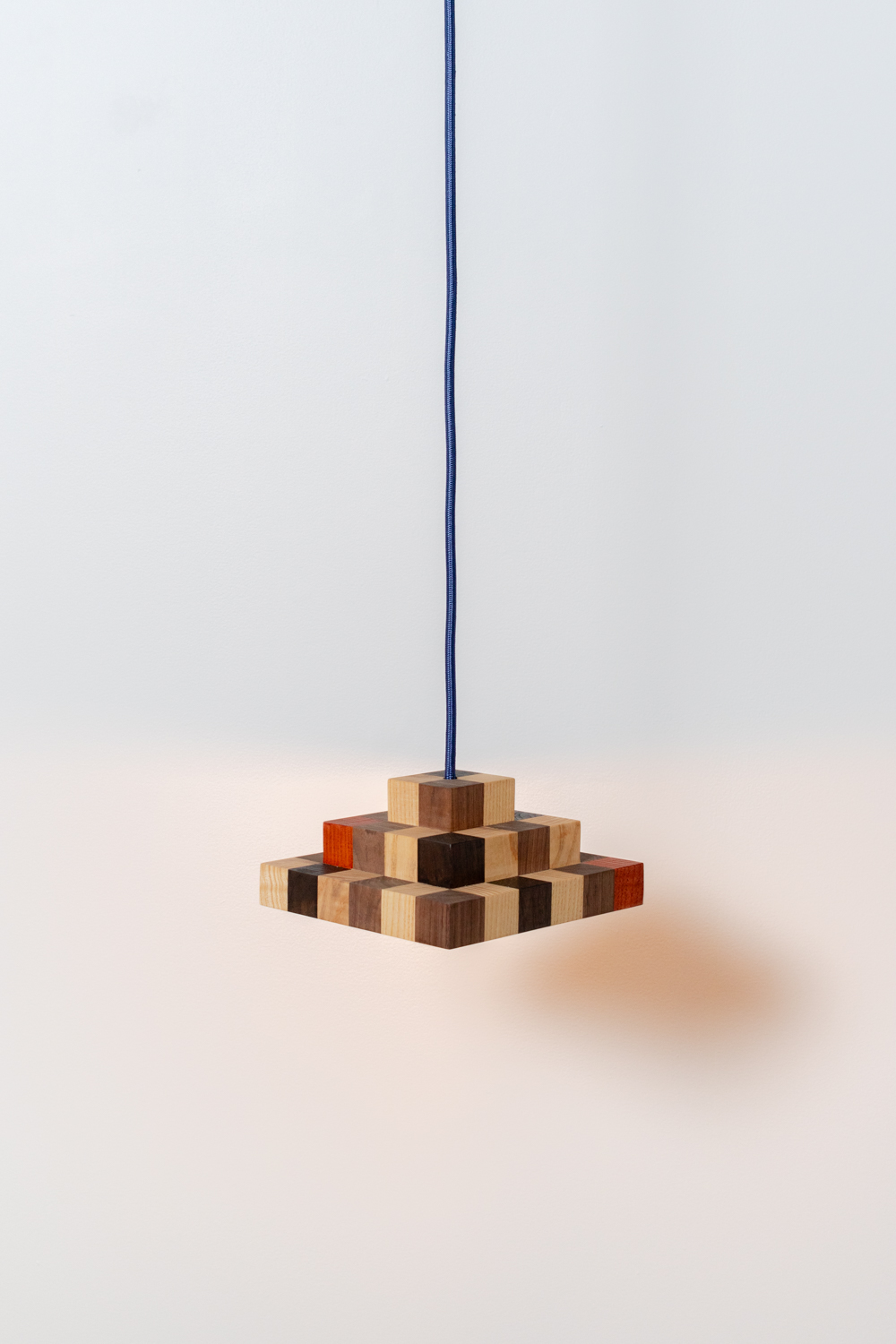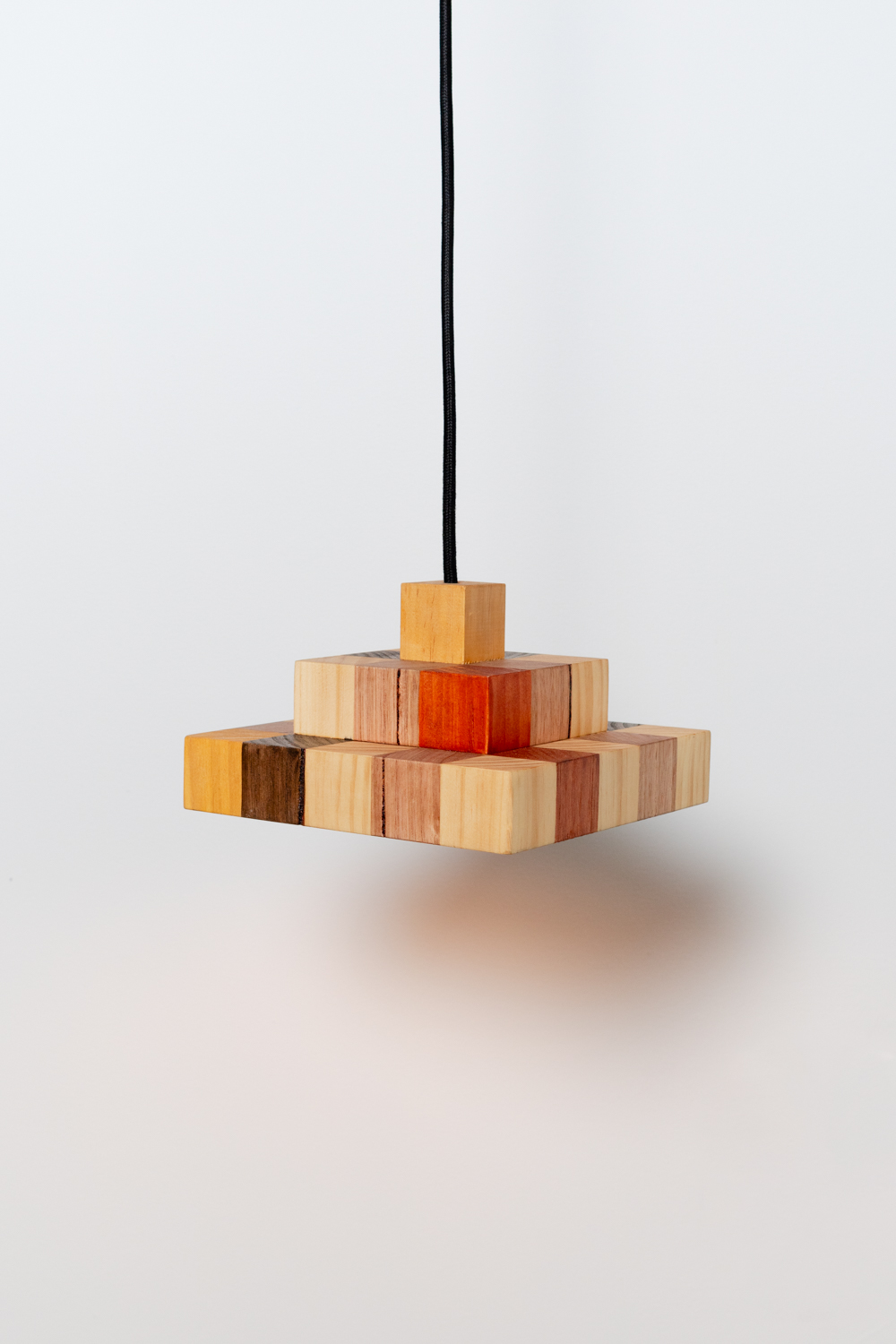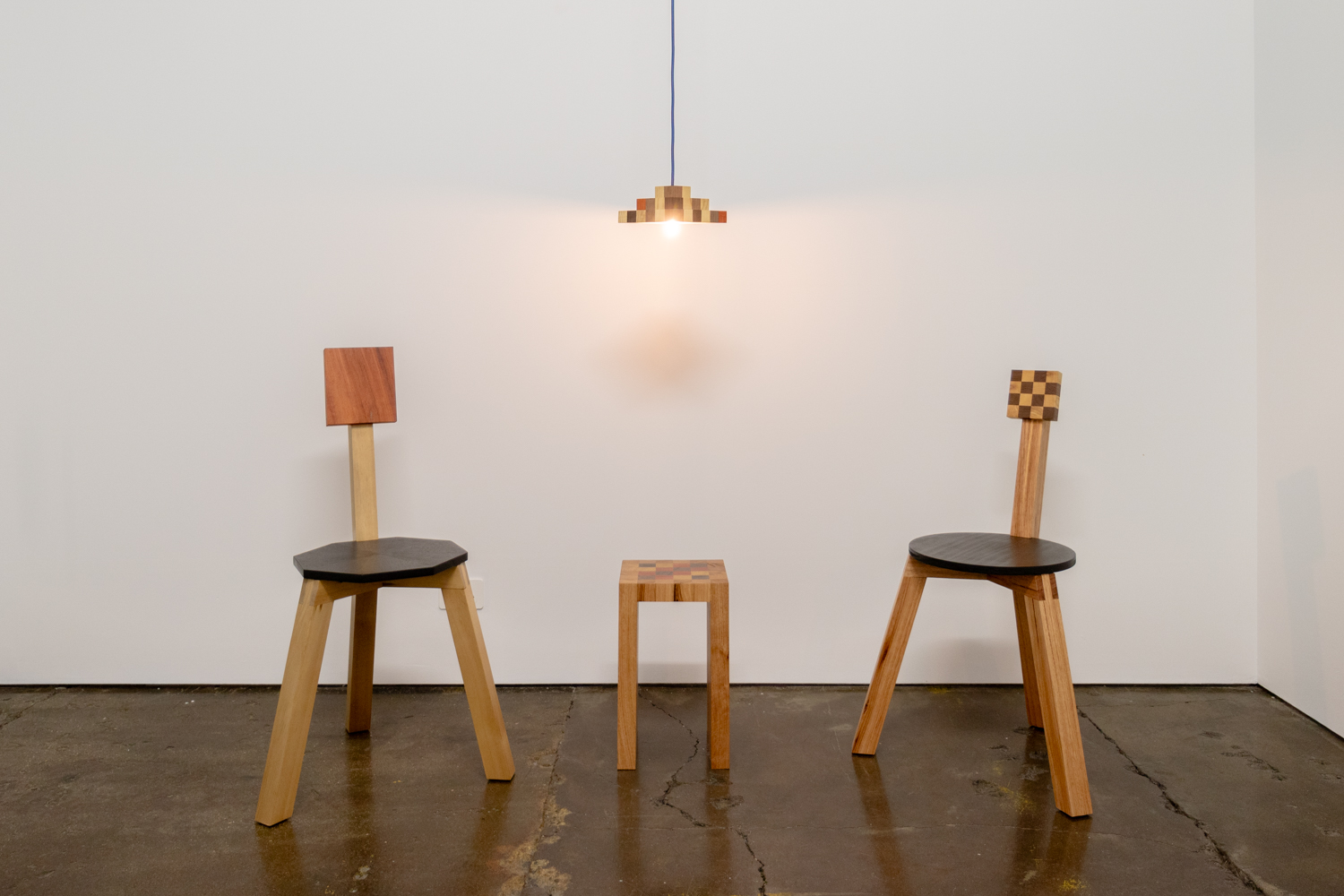Jacqueline Stojanović
24.05.2024 - 22.06.2024
Haydens is pleased to present Colour Ways, Jacqueline Stojanović’s highly anticipated second solo show with the gallery. In this exhibition, three significant bodies of work are brought together in a proliferating grid of colour. An experimental, mural-scaled tapestry is shown alongside wooden mosaics and graph paper drawings, providing the artist with the opportunity to contextualise various longstanding elements of her material practice.
A colourway is a term ordinarily used within a design context to refer to the available arrangements of colour for a particular design. When considered in relation to this exhibition, the term also conveys a sense of the expansive nature of the act of arrangement. Stojanović intuitively draws together divergent concepts, materials, and processes as though they are colours in a colourway.
At the centre of the exhibition is Adria, an epic composition of coloured wool on steel gridded panels. Over the course of many months, threads of wool are hand-wound and sutured to the galvanised steel structures, highlighting the artist’s adept use of colour with a rigid, flashing edge. Stojanović’s respect for traditional weaving processes is counterbalanced by the innovative techniques of combining these contradictory aesthetics. Allusions to the slowness of weaving are contrasted by the immediacy of utilising the gridded found object. Describing the way in which she arranges the colours in this work, the artist explains “There is a wayfinding nature to the process; the final result or destination remains a surprise, even to me.” Through this method, Adria demonstrates a responsive way of making, whereby each colour choice informs the next, creating gradual shifts in hue that represents moving through time.
Bringing together contrasting ideas in cohesive but varied forms, the artworks presented in Colour Ways exemplify the artists ongoing engagement in abstraction, and how the arrangement of colour speaks to an understanding of wayfinding. By visualising the relationships in her aesthetic language, Stojanović lays out a vivid pathway of threads to follow, allowing us to experience a poetic unravelling of her process.
This exhibition is part of The National Gallery of Victoria’s Melbourne Design Week 2024 program.
Jacqueline Stojanović is a multidisciplinary artist living and working on the unceded lands of the Wurundjeri Woi Wurrung people of the eastern Kulin Nation. She is an artist, weaver and educator who works with historic and contemporary textile processes. The impetus of Stojanović’s expanded practice is grafted to her belief in weaving as an ancient carrier of culture. She continues the tradition of hand weaving within a contemporary framework to memorialise the cultural practice of her parents respective homelands in former-Yugoslavia and Vietnam. Her works borrow the vocabulary of Abstraction and assemble a host of materials from the industrial to the domestic, collaging time scapes, memories, translations, built environments, and folk traditions, to navigate shifts in collective social and material values, past and present.
Jacqueline Stojanović—Colour Ways
by Sue Cramer
Under the gentle rubric of Colour Ways, Jacqueline Stojanović brings together three different types of work featuring coloured blocks within a range of evocative gridded formats. ‘All of the works are drawings’ she says, though in ways that expand definitions of the medium.
The mural-scaled Adria 2024 is the exhibition’s stunning centrepiece, a large experimental weaving on industrial steel mesh grids. Stojanović describes her method of making it as ‘drawing with wool’, though threads of cotton, acrylic and satin were also used. The name Adria is linked to the Adriatic Sea that lies between the Italian and Balkan Peninsulas—a region with which Melbourne born Stojanović has family ties through her Serbian heritage, and to which she has travelled in recent years to research local weaving cultures in Eastern Europe—like the age-old textile traditions upheld, against the tide of change, by the women carpet weavers of the Damsko Srce workshop,. In 2016, Stojanović visited this workshop where Pirotski čilim are made in the Serbian township of Pirot.¹
Time, and with it process, seem implicit in Adria’s epic composition. Following the countless generations of weavers working on looms before her, Stojanović spent months making Adria, panel by panel in her studio, rhythmically winding her threads around sections of the metal grid, which effectively serves as an improvised upright loom. One colour leads to another as she constructs her captivating design—a vivid patchwork of irregularly sized rectangles and squares that unfolds as she goes. As one’s eye moves across the finished work, its rich palette subtly shifts from blue to indigo to purple—almost as if day is slowly and magically transitioning into night. Accents of contrasting hues create pleasing inconsistencies—small blocks of bright red, soft orange or pale green, a vibrant orange stripe or a crimson streak—that appear like flashes of inspiration arising along the way.
Adria is the latest in Stojanović’s Grid series, begun in 2019, of geometric abstract works made using readymade metal structures as a frame for her ‘pictures made of wool’. While these works are mostly domestic in size and often made using serviceable objects like oven racks, the expansive Adria, is semi-architectural in scale; at nearly two by six meters, it takes up most of the gallery’s long wall. Of a type normally used for laying concrete, the mesh grids provide a sturdy basis for the wound threads—Stojanović enjoys such contrasts between the industrial and handmade, and the union of the two in her work.
Though she has exhibited numerous artworks made on traditional loom types such as the Countermarch and Jacquard, Stojanović’s Grids are in a category of their own. For a start, the ‘loom’ (or in the case of Adria the industrial mesh) is presented as a visual and material part of the final work, unlike traditional looms, which are used purely as a tool. Further, instead of interlacing her thread, as typical for the construction of textiles, Stojanović separates her warp and weft into different blocks of either vertical or horizontal threads, not actually ‘weaving’ them together in a literal sense at all. This is not from lack of diligence or respect for the process. By using a metal grid as her foundation, Stojanović frees up the potential for ‘drawing’ and pictorial invention—we might think of Anni Albers descriptor of ‘pictorial weavings’, and her call for inventive weavers to explore the relation of textiles to architecture². With due regard for tradition, yet keen eye for innovation, Stojanović’s distinctive technique of winding the wool also borrows from and adapts the time-honoured, pre-loom practice of ‘winding the warp’, a method used by weavers to measure-out their threads by winding lengths around a pegged wooden frame.
Taking breaks from weaving, Stojanović turns to making geometric drawings on graph paper, their various designs underpinned by the paper’s utilitarian pattern of blue squares. Whilst being abstract works in themselves, some of the drawings are also drafts for weaving patterns, designs for carpets, or proposals for a spatial fabric installation. Others, replete with familial memories, show the artist’s recollections of buildings in Belgrade, the city where her mother and grandmother were born in the decades following the founding of Yugoslavia. One drawing evokes colonnades bearing the red and white stripe patterning typical of the city’s ornate Neo-Byzantine architecture; by contrast, another approximates an aerial view of the vast socialist housing project colloquially known as blokovi. These suburban blocks of high-rise apartments, examples of Brutalist architecture, were built as a utopian project in New Belgrade after World War II and remain today as densely populated urban neighbourhoods. As a response, Stojanović made two handwoven tapestries Blokovi I and Blokovi II in 2019 that soften the hard edges of these buildings, while impressing their existence in memory.
Blocks take a literal form in Stojanović’s humble, yet beautifully evocative mosaics made from wooden blocks hand-coloured with pencil. These intimately scaled works from 2024 re-interpret the often elaborate medium of tiled mosaics using simpler composites of abstract colours and shapes that at times have the charm of folk art. As a method of picture-making, mosaics evolved in early Greek and Roman times out of using differently coloured pebbles to make pathways and roads. Stojanović’s mosaics link poetically with these ‘wayfinding’ origins of the medium, whilst also drawing inspiration from the ancient tilework of Byzantium that can still be seen today in the Eastern Orthodox Churches of Belgrade, where they are part of the cultural as much as religious fabric of the city, and which hold a ritualistic significance to her family both here and in Serbia. . Mosaic traditions are also being kept alive in the monumental public artworks more recently commissioned in Belgrade from noted contemporary Yugoslavartists, such as Lazar Vujaklija and Marij Pregeil, whose work is admired by Stojanović. Most of Stojanović’s gridded wood blocks are arranged in square or diamond configurations, whilst some take a long and narrow shape suggestive of columns or pathways. The Neo-Byzantine colourway of red and cream seen in Stojanović’s drawings appears again in some of these wooden works, while other examples have looser, more intuitive colour schemes. Echoing the natural stone of early pebble mosaics, Stojanović chooses to work with natural oak and pine. There is an apt correspondence between the material constituents of the coloured pencils, and the works themselves; both are simply made from wood and pigmented lead.
With a lightness of touch and joyful appreciation of her materials and methods, Stojanović looks to the handmade traditions of Eastern Europe, whilst re-inventing them for the present. Her Colour Ways call us to join her on a journey full of insights and surprising aesthetic pleasures.
¹ See Jacqueline Stojanović, ‘Damsko Srce: Heritage hanging by a thread’ in Garland Magazine, Melbourne, 1 December 2022, accessed online, Melbourne, 29 April 2024, https://garlandmag.com/article/damsko-srce-pirot-carpet/
² Anni Albers ‘The Pliable Plane: Textiles in Architecture’, originally published in Perspecta: The Yale Architectural Journal, vol 4, 1957, pp 36–41, reprinted with permission from the Josef and Anni Albers Foundation, New York in Pliable Planes; Expanded Textile and Fibre Practices, exhibition catalogue, UNSW Galleries, Sydney, 2022, pp 33–40
A colourway is a term ordinarily used within a design context to refer to the available arrangements of colour for a particular design. When considered in relation to this exhibition, the term also conveys a sense of the expansive nature of the act of arrangement. Stojanović intuitively draws together divergent concepts, materials, and processes as though they are colours in a colourway.
At the centre of the exhibition is Adria, an epic composition of coloured wool on steel gridded panels. Over the course of many months, threads of wool are hand-wound and sutured to the galvanised steel structures, highlighting the artist’s adept use of colour with a rigid, flashing edge. Stojanović’s respect for traditional weaving processes is counterbalanced by the innovative techniques of combining these contradictory aesthetics. Allusions to the slowness of weaving are contrasted by the immediacy of utilising the gridded found object. Describing the way in which she arranges the colours in this work, the artist explains “There is a wayfinding nature to the process; the final result or destination remains a surprise, even to me.” Through this method, Adria demonstrates a responsive way of making, whereby each colour choice informs the next, creating gradual shifts in hue that represents moving through time.
Bringing together contrasting ideas in cohesive but varied forms, the artworks presented in Colour Ways exemplify the artists ongoing engagement in abstraction, and how the arrangement of colour speaks to an understanding of wayfinding. By visualising the relationships in her aesthetic language, Stojanović lays out a vivid pathway of threads to follow, allowing us to experience a poetic unravelling of her process.
This exhibition is part of The National Gallery of Victoria’s Melbourne Design Week 2024 program.
Jacqueline Stojanović is a multidisciplinary artist living and working on the unceded lands of the Wurundjeri Woi Wurrung people of the eastern Kulin Nation. She is an artist, weaver and educator who works with historic and contemporary textile processes. The impetus of Stojanović’s expanded practice is grafted to her belief in weaving as an ancient carrier of culture. She continues the tradition of hand weaving within a contemporary framework to memorialise the cultural practice of her parents respective homelands in former-Yugoslavia and Vietnam. Her works borrow the vocabulary of Abstraction and assemble a host of materials from the industrial to the domestic, collaging time scapes, memories, translations, built environments, and folk traditions, to navigate shifts in collective social and material values, past and present.
Jacqueline Stojanović—Colour Ways
by Sue Cramer
Under the gentle rubric of Colour Ways, Jacqueline Stojanović brings together three different types of work featuring coloured blocks within a range of evocative gridded formats. ‘All of the works are drawings’ she says, though in ways that expand definitions of the medium.
The mural-scaled Adria 2024 is the exhibition’s stunning centrepiece, a large experimental weaving on industrial steel mesh grids. Stojanović describes her method of making it as ‘drawing with wool’, though threads of cotton, acrylic and satin were also used. The name Adria is linked to the Adriatic Sea that lies between the Italian and Balkan Peninsulas—a region with which Melbourne born Stojanović has family ties through her Serbian heritage, and to which she has travelled in recent years to research local weaving cultures in Eastern Europe—like the age-old textile traditions upheld, against the tide of change, by the women carpet weavers of the Damsko Srce workshop,. In 2016, Stojanović visited this workshop where Pirotski čilim are made in the Serbian township of Pirot.¹
Time, and with it process, seem implicit in Adria’s epic composition. Following the countless generations of weavers working on looms before her, Stojanović spent months making Adria, panel by panel in her studio, rhythmically winding her threads around sections of the metal grid, which effectively serves as an improvised upright loom. One colour leads to another as she constructs her captivating design—a vivid patchwork of irregularly sized rectangles and squares that unfolds as she goes. As one’s eye moves across the finished work, its rich palette subtly shifts from blue to indigo to purple—almost as if day is slowly and magically transitioning into night. Accents of contrasting hues create pleasing inconsistencies—small blocks of bright red, soft orange or pale green, a vibrant orange stripe or a crimson streak—that appear like flashes of inspiration arising along the way.
Adria is the latest in Stojanović’s Grid series, begun in 2019, of geometric abstract works made using readymade metal structures as a frame for her ‘pictures made of wool’. While these works are mostly domestic in size and often made using serviceable objects like oven racks, the expansive Adria, is semi-architectural in scale; at nearly two by six meters, it takes up most of the gallery’s long wall. Of a type normally used for laying concrete, the mesh grids provide a sturdy basis for the wound threads—Stojanović enjoys such contrasts between the industrial and handmade, and the union of the two in her work.
Though she has exhibited numerous artworks made on traditional loom types such as the Countermarch and Jacquard, Stojanović’s Grids are in a category of their own. For a start, the ‘loom’ (or in the case of Adria the industrial mesh) is presented as a visual and material part of the final work, unlike traditional looms, which are used purely as a tool. Further, instead of interlacing her thread, as typical for the construction of textiles, Stojanović separates her warp and weft into different blocks of either vertical or horizontal threads, not actually ‘weaving’ them together in a literal sense at all. This is not from lack of diligence or respect for the process. By using a metal grid as her foundation, Stojanović frees up the potential for ‘drawing’ and pictorial invention—we might think of Anni Albers descriptor of ‘pictorial weavings’, and her call for inventive weavers to explore the relation of textiles to architecture². With due regard for tradition, yet keen eye for innovation, Stojanović’s distinctive technique of winding the wool also borrows from and adapts the time-honoured, pre-loom practice of ‘winding the warp’, a method used by weavers to measure-out their threads by winding lengths around a pegged wooden frame.
Taking breaks from weaving, Stojanović turns to making geometric drawings on graph paper, their various designs underpinned by the paper’s utilitarian pattern of blue squares. Whilst being abstract works in themselves, some of the drawings are also drafts for weaving patterns, designs for carpets, or proposals for a spatial fabric installation. Others, replete with familial memories, show the artist’s recollections of buildings in Belgrade, the city where her mother and grandmother were born in the decades following the founding of Yugoslavia. One drawing evokes colonnades bearing the red and white stripe patterning typical of the city’s ornate Neo-Byzantine architecture; by contrast, another approximates an aerial view of the vast socialist housing project colloquially known as blokovi. These suburban blocks of high-rise apartments, examples of Brutalist architecture, were built as a utopian project in New Belgrade after World War II and remain today as densely populated urban neighbourhoods. As a response, Stojanović made two handwoven tapestries Blokovi I and Blokovi II in 2019 that soften the hard edges of these buildings, while impressing their existence in memory.
Blocks take a literal form in Stojanović’s humble, yet beautifully evocative mosaics made from wooden blocks hand-coloured with pencil. These intimately scaled works from 2024 re-interpret the often elaborate medium of tiled mosaics using simpler composites of abstract colours and shapes that at times have the charm of folk art. As a method of picture-making, mosaics evolved in early Greek and Roman times out of using differently coloured pebbles to make pathways and roads. Stojanović’s mosaics link poetically with these ‘wayfinding’ origins of the medium, whilst also drawing inspiration from the ancient tilework of Byzantium that can still be seen today in the Eastern Orthodox Churches of Belgrade, where they are part of the cultural as much as religious fabric of the city, and which hold a ritualistic significance to her family both here and in Serbia. . Mosaic traditions are also being kept alive in the monumental public artworks more recently commissioned in Belgrade from noted contemporary Yugoslavartists, such as Lazar Vujaklija and Marij Pregeil, whose work is admired by Stojanović. Most of Stojanović’s gridded wood blocks are arranged in square or diamond configurations, whilst some take a long and narrow shape suggestive of columns or pathways. The Neo-Byzantine colourway of red and cream seen in Stojanović’s drawings appears again in some of these wooden works, while other examples have looser, more intuitive colour schemes. Echoing the natural stone of early pebble mosaics, Stojanović chooses to work with natural oak and pine. There is an apt correspondence between the material constituents of the coloured pencils, and the works themselves; both are simply made from wood and pigmented lead.
With a lightness of touch and joyful appreciation of her materials and methods, Stojanović looks to the handmade traditions of Eastern Europe, whilst re-inventing them for the present. Her Colour Ways call us to join her on a journey full of insights and surprising aesthetic pleasures.
¹ See Jacqueline Stojanović, ‘Damsko Srce: Heritage hanging by a thread’ in Garland Magazine, Melbourne, 1 December 2022, accessed online, Melbourne, 29 April 2024, https://garlandmag.com/article/damsko-srce-pirot-carpet/
² Anni Albers ‘The Pliable Plane: Textiles in Architecture’, originally published in Perspecta: The Yale Architectural Journal, vol 4, 1957, pp 36–41, reprinted with permission from the Josef and Anni Albers Foundation, New York in Pliable Planes; Expanded Textile and Fibre Practices, exhibition catalogue, UNSW Galleries, Sydney, 2022, pp 33–40








